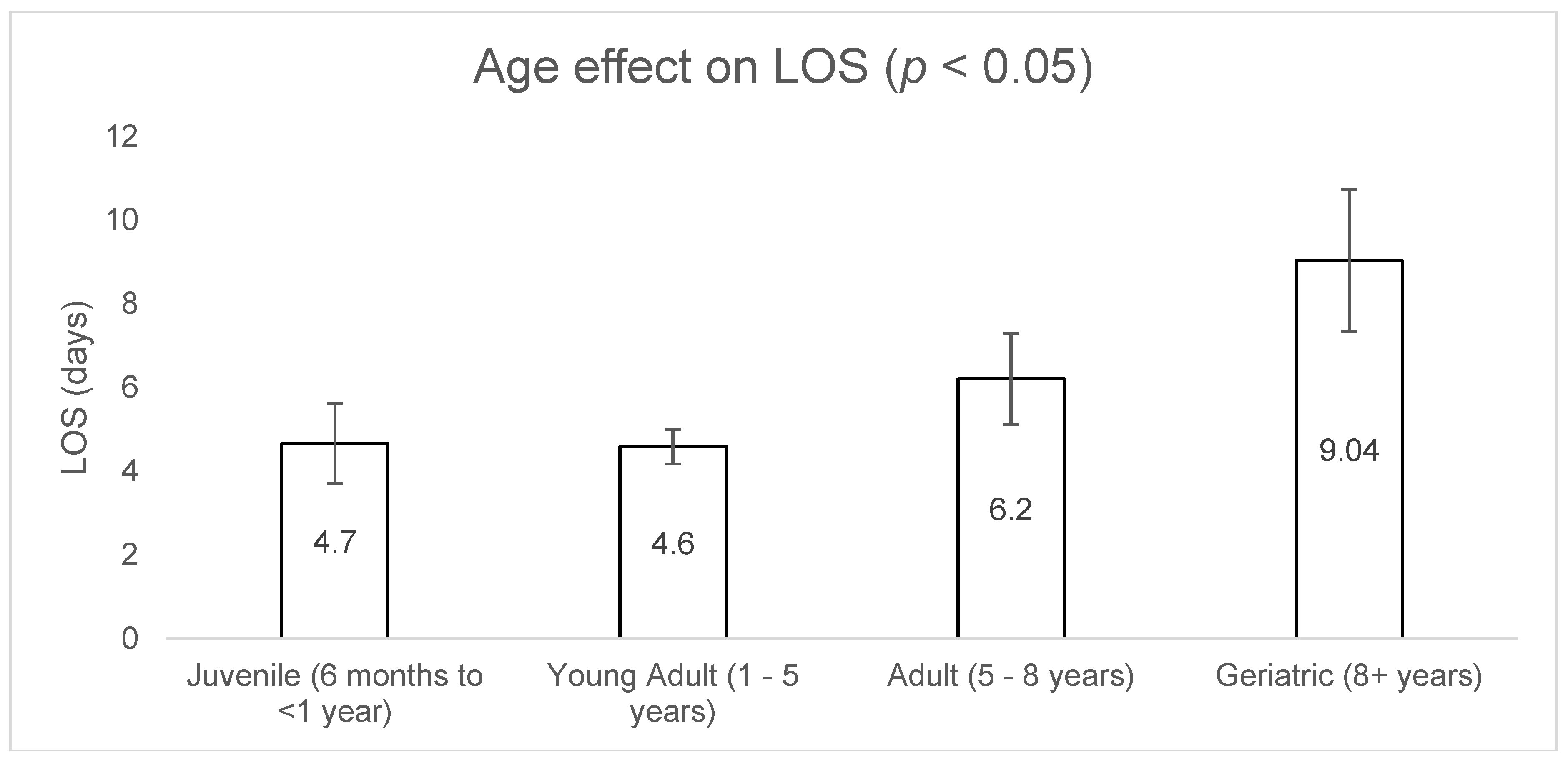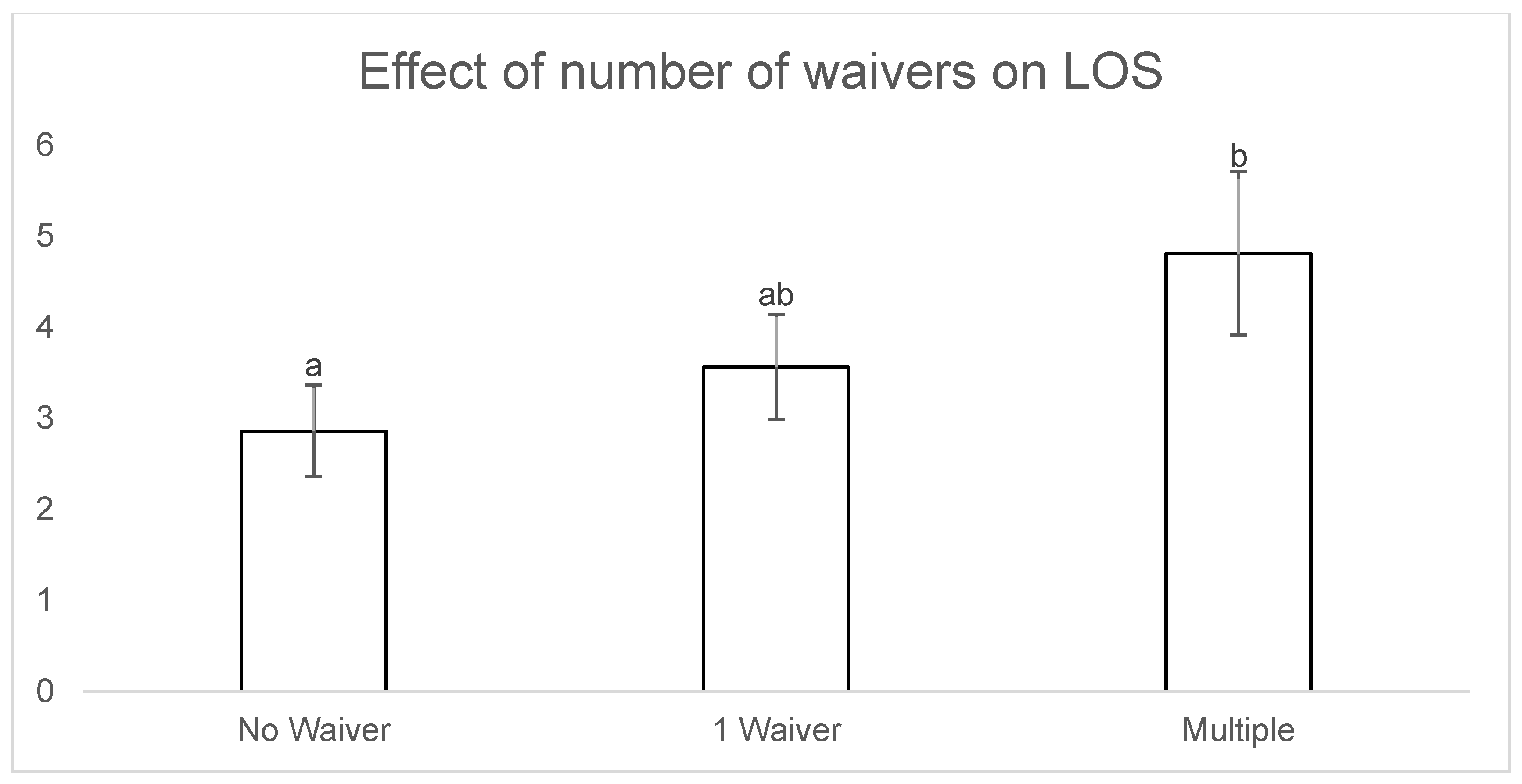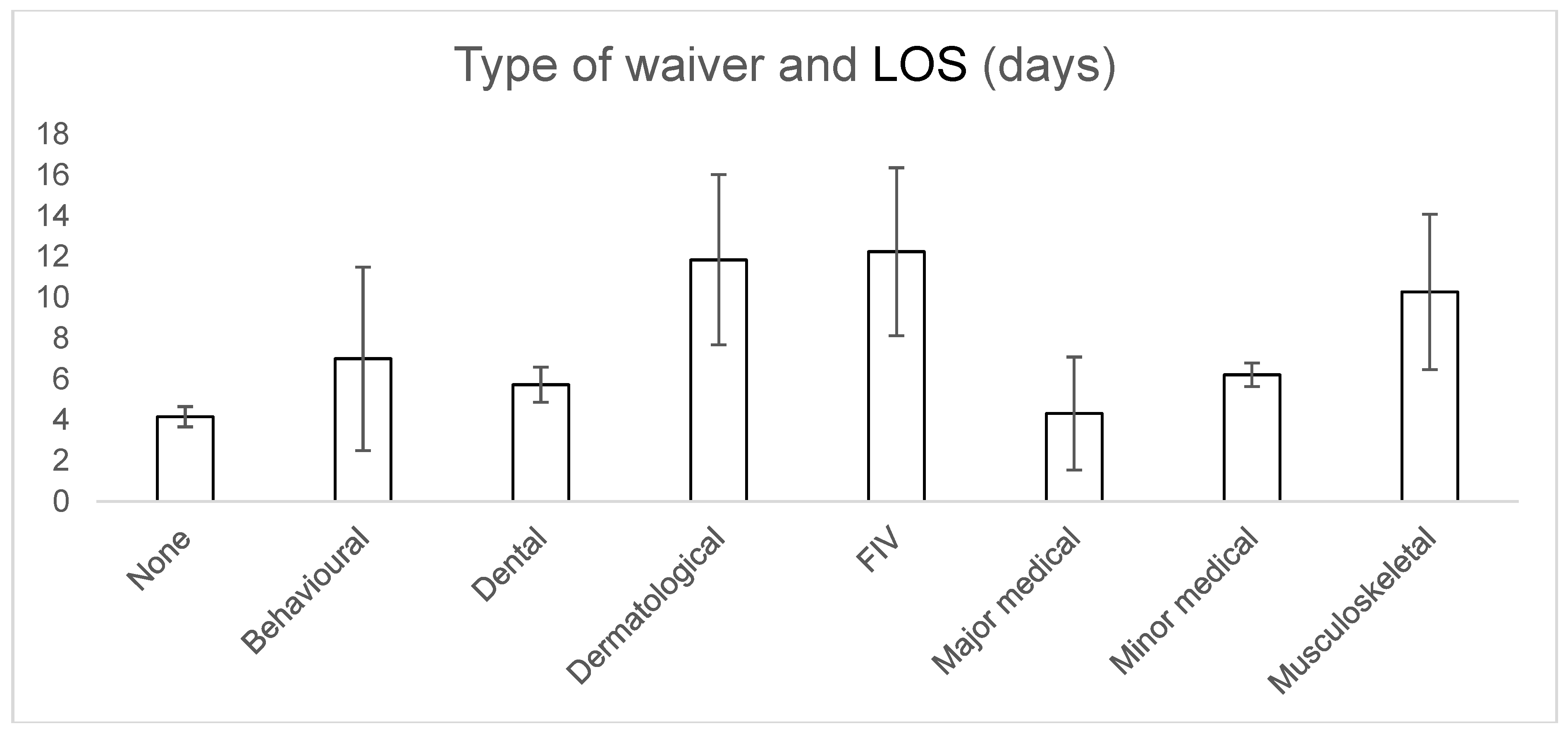Investigating the Impact of Indemnity Waivers on the Length of Stay of Cats at an Australian Shelter
Abstract
:Simple Summary
Abstract
1. Introduction
2. Materials and Methods
2.1. Study Population
2.2. Description of Data Set
2.3. Age Categories
2.4. Breed Designations
2.5. Coat Colour Definitions
2.6. Length of Stay (LOS)
2.7. Waiver Type and Waiver Number
2.8. Returned Cats
2.9. Statistical Analysis
2.10. Ethics Approval
3. Results
3.1. Study Population
3.2. Univariate Analysis
3.3. Multivariate Analysis
3.4. Bimodal Analysis
4. Discussion
5. Conclusions
Author Contributions
Funding
Conflicts of Interest
References
- Royal Society for the Prevention of Cruelty to Animals. RSPCA Australian National Statistics 2016–2017. Available online: https://www.rspca.org.au/sites/default/files/RSPCA%20Australia%20Annual%20Statistics%20final%202016-2017.pdf (accessed on 2 February 2018).
- Janke, N.; Berke, O.; Flockhart, T.; Bateman, S.; Coe, J.B. Risk factors affecting length of stay of cats in an animal shelter: A case study at the Guelph Humane Society, 2011–2016. Prev. Vet. Med. 2017, 148, 44–48. [Google Scholar] [CrossRef] [PubMed]
- Dinnage, J.D.; Scarlett, J.M.; Richards, J.R. Descriptive epidemiology of feline upper respiratory tract disease in an animal shelter. J. Feline Med. Surg. 2009, 11, 816–825. [Google Scholar] [CrossRef] [PubMed]
- Edinboro, C.H.; Janowitz, L.K.; Guptill-Yoran, L.; Glickman, L.T. A clinical trial of intranasal and subcutaneous vaccines to prevent upper respiratory infection in cats at an animal shelter. Feline Pract. 1999, 27, 7–11. [Google Scholar]
- Federation of Humane Societies—Animal Shelter Statistics 2015. Available online: https://www.stratfordcanada.ca/en/insidecityhall/resources/Animal-Control/CFHS-Report---2015-Animal-Shelter-Statistics.pdf (accessed on 2 February 2018).
- Gouveia, K.; Magalhaes, A.; de Sousa, L. The behavior of domestic cats in a shelter: Residence time, density and sex ratio. Appl. Anim. Behav. Sci. 2011, 130, 53–59. [Google Scholar] [CrossRef]
- Dybdall, K.; Strasser, R. Is there a bias against stray cats in shelters? People’s perception of shelter cats and how it influences adoption time. J. Anthrozoös 2014, 27, 603–614. [Google Scholar] [CrossRef]
- Kubesova, K.; Voslarova, E.; Vecerek, V.; Vucinic, M. Investigating some of the factors that affect the selection of shelter cats by adopters in the Czech Republic. J. Anthrozoös 2017, 30, 623–633. [Google Scholar] [CrossRef]
- Delgado, M.M.; Munera, J.D.; Reevy, G.M. Human perceptions of coat color as an indicator of domestic cat personality. J. Anthrozoös 2017, 25, 427–440. [Google Scholar] [CrossRef]
- Fantuzzi, J.M.; Miller, K.A.; Weiss, E. Factors relevant to adoption of cats in an animal shelter. J. Appl. Anim. Welf. Sci. 2010, 13, 174–179. [Google Scholar] [CrossRef] [PubMed]
- Gourkow, N.; Fraser, D. The effect of housing and handling practices on the welfare, behaviour and selection of domestic cats (Felis sylvestris catus) by adopters in an animal shelter. Anim. Welf. 2006, 15, 371–377. [Google Scholar]
- Kry, K.; Casey, R. The effect of hiding enrichment on stress levels and behavior of domestic cats (Felis sylvestris catus) in a shelter setting and the implications for adoption potential. Anim. Welf. 2007, 16, 375–383. [Google Scholar]
- Weiss, E.; Miller, K.; Mohan-Gibbons, H.; Vela, C. Why did you choose this pet? Adopters and pet selection preferences in five animal shelters in the United States. Animals 2012, 2, 144–159. [Google Scholar] [CrossRef] [PubMed]
- Brown, W.P.; Morgan, K.T. Age, breed designation, coat colour, and coat pattern influences the length of stay of cats at a no-kill shelter. J. Appl. Anim. Welf. Sci. 2015, 18, 169–180. [Google Scholar] [CrossRef] [PubMed]
- Onodera, N.; Uchida, K.; Kakuma, Y. Association between characteristics of cats and satisfaction of owners who adopted cats from an animal hospital in Japan. J. Vet. Med. Sci. 2014, 76, 729–733. [Google Scholar] [CrossRef] [PubMed]
- Lepper, M.; Kass, P.; Hart, L. Prediction of adoption versus euthanasia among dogs and cats in a California animal shelter. J. Appl. Anim. Welf. Sci. 2002, 5, 29–42. [Google Scholar] [CrossRef] [PubMed]
- Alberthsen, C.; Rand, J.S.; Bennett, P.C.; Paterson, M.; Lawrie, M.; Morton, J.M. Cat admissions to RSPCA shelters in Queensland, Australia: Description of cats and risk factors for euthanasia after entry. Aust. Vet. J. 2013, 95, 35–42. [Google Scholar] [CrossRef] [PubMed]
- Mullan, S. Are you positive? The fate of a shelter cat. Practice 2012, 34, 550–551. [Google Scholar] [CrossRef]
- Hosie, M.J.; Addie, D.; Belak, S.; Boucraut-Baralon, C.; Egberink, H.; Frymus, T.; Gruffydd-Jones, T.; Hartmann, K.; Lloret, A.; Lutz, H.; et al. Feline immunodeficiency ABCD guidelines on prevention and management. J. Feline Med. Surg. 2009, 11, 575–584. [Google Scholar] [CrossRef] [PubMed]



| Waiver | Explanation or Reason for Waiver |
|---|---|
| Obesity (n = 5) | Animal requires weight reduction program to return to a healthy weight. |
| Squamous cell carcinoma (SCC) risk (n = 95) | Risk of SCC due to white or pink features on face and ears. |
| ‘Cat flu’ (n = 33) | Exposed or previously contracted cat flu (feline upper respiratory tract disease), likely to have latent viral infection for life. |
| Umbilical hernia (n = 1) | A condition in which intestines may possibly protrude through the abdominal muscles at the umbilicus. |
| FLUTD (feline lower urinary tract disease) (n = 7) | Showed evidence of blood in urine or FLUTD-like signs whilst in care, possibly predisposed to FLUTD in the future. |
| Ringworm (n = 5) | Exposed or previously contracted ringworm. |
| Flea allergy dermatitis (FAD) (n = 1) | Showed signs of FAD in care, owners will need to continue flea treatment to prevent recurrence. |
| Dental disease (n = 44) | Minor or major dental disease identified on examination, likely to require some treatment for dental disease in future (minor = scale and polish, major = extractions). |
| Teeth extracted (n = 11) | Major dental surgery performed with the possibility for future dental disease, similar to waiver ‘Dental disease’ |
| Osteoarthritis (n = 6) | Evidence of arthritis, management of condition required in future. |
| Tremoring (n = 1) | Undiagnosed neurological tremor. |
| Abscess (n = 1) | Presented to shelter with an abscess which was in the process of healing. |
| FIV (feline immunodeficiency virus) (n = 12) | Tested FIV-positive, not showing clinical signs, disease may progress in future. |
| Feline acne (n = 3) | Evidence of feline acne whilst in care, management changes will be required in future. |
| Femoral head excision (FHE) (n = 1) | Femoral head was surgically removed in care due to previous trauma, ongoing management may be required. |
| Pelvic fractures (n = 1) | Old injury, likely will have arthritis in future. |
| Luxating patella (n = 1) | Diagnosed with a low grade luxating patella, not surgically corrected, may require ongoing management. |
| Hyperthyroidism (n = 1) | Surrendered on hyperthyroid medication, however no clinical signs while in care and T3 and T4 levels normal. May require treatment for hyperthyroidism in the future. |
| CKD (chronic kidney disease) (n = 1) | Diagnosed with CKD whilst in care, management of the condition will be required. |
| Oral trauma (n = 1) | Presented as such, still healing during adoption. |
| Corneal ulceration (n = 1) | Presented as such, still healing during adoption. |
| Anxiety (n = 1) | Will need ongoing management. |
| Skin mites (n = 1) | Diagnosed whilst in care and treated but might reoccur. |
| Pica (n = 1) | The persistent behaviour of eating non-food material (e.g., blankets, socks, grocery bags). |
| Medical fail (n = 1) | Chronic medical issue likely to deteriorate with time (e.g., advanced CKD, congenital heart disease). |
| Wound (n = 1) | Presented with large skin wound, still healing during adoption. |
| Waiver Type | Waivers Included |
|---|---|
| Behavioural | Pica, anxiety and tremoring |
| Feline immunodeficiency virus (FIV) | FIV-positive |
| Major medical | CKD, hyperthyroidism and medical fail |
| Minor medical | Abscess, umbilical hernia, obesity, ‘cat flu’, SCC risk, oral trauma, corneal ulceration, wound and FLUTD |
| Musculoskeletal | Luxating patella, FHE, pelvic fractures and osteoarthritis |
| Dermatological | Skin mites, FAD, feline acne and ringworm |
| Dental disease | Minor dental disease—without extractions; major dental disease—with extractions |
| Variable | Categories | Number |
|---|---|---|
| Sex | Male | 116 |
| Female | 133 | |
| Breed | Non-purebred | 234 |
| Purebred | 15 | |
| Age | Juveniles (6–12 months) | 28 |
| Young adults (1–5 years) | 145 | |
| Adults (5–8 years) | 38 | |
| Geriatrics (>8 years) | 34 | |
| Unknown | 4 | |
| Coat colour | Dark | 55 |
| Ginger | 8 | |
| White | 11 | |
| Grey | 12 | |
| Two tone | 38 | |
| Tortoiseshell | 30 | |
| Tabby | 95 | |
| Waiver presence | Yes | 163 |
| No | 86 | |
| Waiver number | No waiver | 88 |
| One waiver | 99 | |
| Multiple waivers (i.e., 2 or more) * | 62 | |
| Waiver type | Behavioural | 3 |
| Feline immunodeficiency virus (FIV) | 11 | |
| Major medical | 3 | |
| Minor medical | 146 | |
| Musculoskeletal | 9 | |
| Dermatological | 10 | |
| Dental disease | 55 |
| Name of Variable | Wald Statistic | n.d.f | F Statistic | d.d.f | F pr |
|---|---|---|---|---|---|
| Sex | 1.03 | 1 | 1.03 | 247.0 | 0.312 |
| Breed | 10.91 | 1 | 10.91 | 247.0 | 0.001 |
| Age | 11.95 | 3 | 3.98 | 241.0 | 0.009 |
| Colour | 5.56 | 6 | 0.93 | 242.0 | 0.476 |
| Waiver (yes/no) | 5.97 | 1 | 5.97 | 247.0 | 0.015 |
| Total waiver number (0, 1, 2+) | 10.39 | 2 | 5.19 | 246.0 | 0.006 |
| Name of Variable | Wald Statistic | n.d.f | F Statistic | d.d.f | F pr |
|---|---|---|---|---|---|
| Age | 13.63 | 3 | 4.54 | 238.0 | 0.004 |
| Breed | 17.36 | 1 | 17.36 | 238.0 | <0.001 |
| Waiver number | 8.41 | 2 | 4.20 | 238.0 | 0.016 |
© 2019 by the authors. Licensee MDPI, Basel, Switzerland. This article is an open access article distributed under the terms and conditions of the Creative Commons Attribution (CC BY) license (http://creativecommons.org/licenses/by/4.0/).
Share and Cite
Pockett, J.; Orr, B.; Hall, E.; Chong, W.L.; Westman, M. Investigating the Impact of Indemnity Waivers on the Length of Stay of Cats at an Australian Shelter. Animals 2019, 9, 50. https://doi.org/10.3390/ani9020050
Pockett J, Orr B, Hall E, Chong WL, Westman M. Investigating the Impact of Indemnity Waivers on the Length of Stay of Cats at an Australian Shelter. Animals. 2019; 9(2):50. https://doi.org/10.3390/ani9020050
Chicago/Turabian StylePockett, Jessica, Bronwyn Orr, Evelyn Hall, Wye Li Chong, and Mark Westman. 2019. "Investigating the Impact of Indemnity Waivers on the Length of Stay of Cats at an Australian Shelter" Animals 9, no. 2: 50. https://doi.org/10.3390/ani9020050
APA StylePockett, J., Orr, B., Hall, E., Chong, W. L., & Westman, M. (2019). Investigating the Impact of Indemnity Waivers on the Length of Stay of Cats at an Australian Shelter. Animals, 9(2), 50. https://doi.org/10.3390/ani9020050





